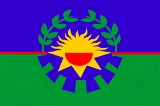
Carmen de Patagones
Encyclopedia
Geography
It is located 937 km from the city of Buenos AiresBuenos Aires
Buenos Aires is the capital and largest city of Argentina, and the second-largest metropolitan area in South America, after São Paulo. It is located on the western shore of the estuary of the Río de la Plata, on the southeastern coast of the South American continent...
, on the north bank of the Río Negro ("Black River"), near the Atlantic Ocean
Atlantic Ocean
The Atlantic Ocean is the second-largest of the world's oceanic divisions. With a total area of about , it covers approximately 20% of the Earth's surface and about 26% of its water surface area...
, and opposite Viedma, capital of the province of Río Negro
Río Negro Province
Río Negro is a province of Argentina, located at the northern edge of Patagonia. Neighboring provinces are from the south clockwise Chubut, Neuquén, Mendoza, La Pampa and Buenos Aires. To the east lies the Atlantic Ocean.Its capital is Viedma...
. The city is the capital of the Patagones Partido
Partido
A partido is an administrative subdivision of the . They are formally considered to be a single municipality, and usually contain one or more population centers...
, the only administrative division of Buenos Aires Province that lies within Patagonia
Patagonia
Patagonia is a region located in Argentina and Chile, integrating the southernmost section of the Andes mountains to the southwest towards the Pacific ocean and from the east of the cordillera to the valleys it follows south through Colorado River towards Carmen de Patagones in the Atlantic Ocean...
.
History

Conquistador
Conquistadors were Spanish soldiers, explorers, and adventurers who brought much of the Americas under the control of Spain in the 15th to 16th centuries, following Europe's discovery of the New World by Christopher Columbus in 1492...
leading a Spanish
Spanish Empire
The Spanish Empire comprised territories and colonies administered directly by Spain in Europe, in America, Africa, Asia and Oceania. It originated during the Age of Exploration and was therefore one of the first global empires. At the time of Habsburgs, Spain reached the peak of its world power....
expedition commissioned with colonizing Patagonia's shores.
In the 19th century, Carmen de Patagones had a fort, and after the May Revolution
May Revolution
The May Revolution was a week-long series of events that took place from May 18 to 25, 1810, in Buenos Aires, capital of the Viceroyalty of the Río de la Plata, a Spanish colony that included roughly the territories of present-day Argentina, Bolivia, Paraguay and Uruguay...
of 1810, it became a prison for royalists (Spaniards and pro-Spanish locals against the independence movement
Argentine War of Independence
The Argentine War of Independence was fought from 1810 to 1818 by Argentine patriotic forces under Manuel Belgrano, Juan José Castelli and José de San Martín against royalist forces loyal to the Spanish crown...
).
Later, during the Argentina-Brazil War
Argentina-Brazil War
The Cisplatine War or the Argentine–Brazilian War was an armed conflict over an area known as Banda Oriental or "Eastern Shore" in the 1820s between the United Provinces of River Plate and the Empire of Brazil in the aftermath of the United Provinces' emancipation from Spain.-Background:Led by...
(1825–1828), the town became a naval base, since the main Argentine safe harbour, the estuary of the Río de la Plata
Río de la Plata
The Río de la Plata —sometimes rendered River Plate in British English and the Commonwealth, and occasionally rendered [La] Plata River in other English-speaking countries—is the river and estuary formed by the confluence of the Uruguay River and the Paraná River on the border between Argentina and...
, had been blocked by Brazilian ships. The Brazilian troops attempted to take Carmen de Patagones, but they were repelled by the civilians on 7 March 1827; this date is still commemorated with a festival in the city. The city maintains two imperial Brazilian flags captured during the battle in the central cathedral on the site of the original fort where the battle took place.
The town and its twin city, Viedma, became the focus of attention in 1986, when President Raúl Alfonsín
Raúl Alfonsín
Raúl Ricardo Alfonsín was an Argentine lawyer, politician and statesman, who served as the President of Argentina from December 10, 1983, to July 8, 1989. Alfonsín was the first democratically-elected president of Argentina following the military government known as the National Reorganization...
announced the Patagonia Project, which envisaged the transfer of the nation's capital to a new federal district encompassing the two towns at the mouth of the Río Negro. Approved by Congress in 1987, the plan was rescinded when Alfonsín's successor, President Carlos Menem
Carlos Menem
Carlos Saúl Menem is an Argentine politician who was President of Argentina from 1989 to 1999. He is currently an Argentine National Senator for La Rioja Province.-Early life:...
, disbanded Entecap, the
commission overseeing the project, in 1989.

